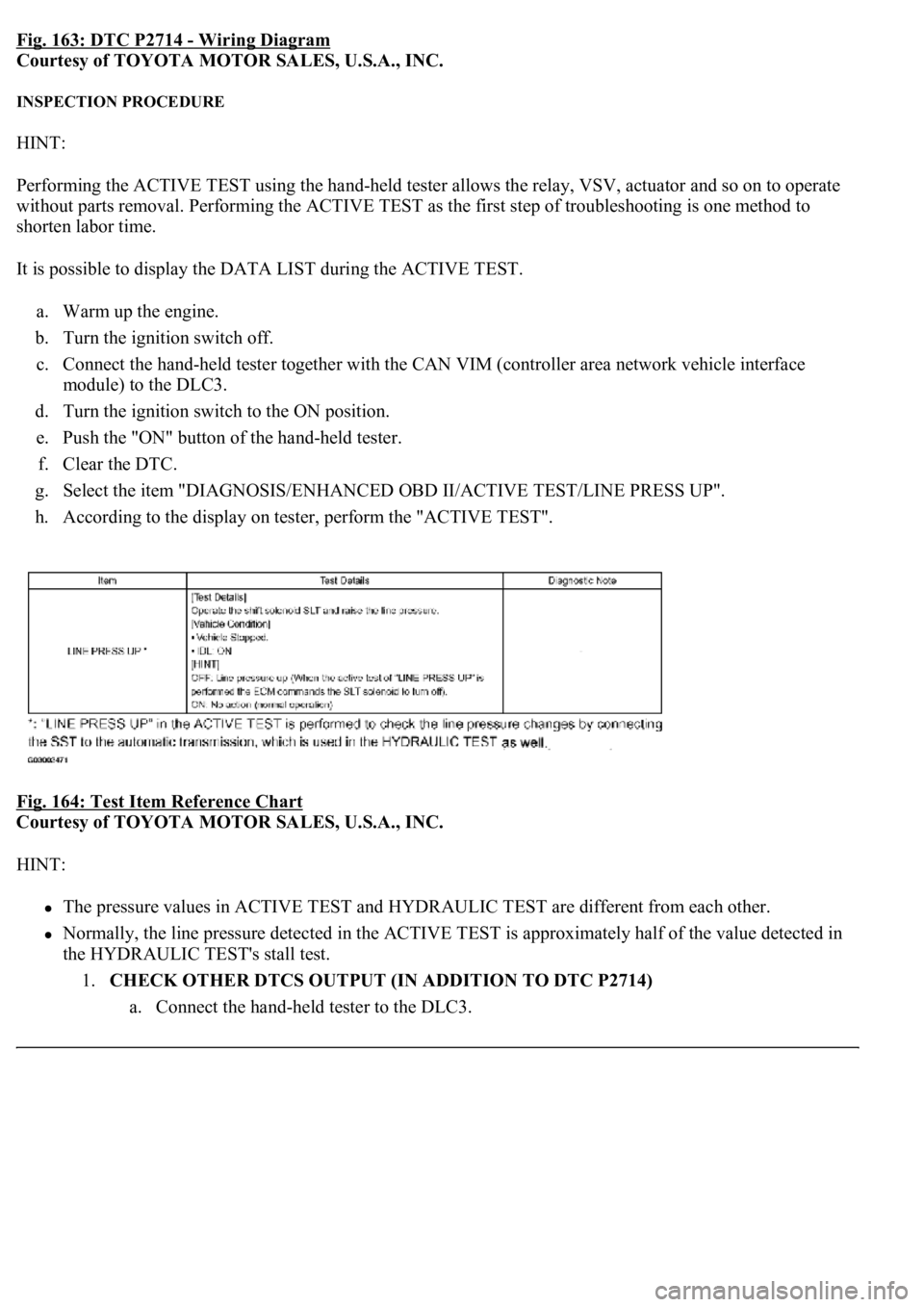Page 2859 of 4500

Fig. 163: DTC P2714 - Wiring Diagram
Courtesy of TOYOTA MOTOR SALES, U.S.A., INC.
INSPECTION PROCEDURE
HINT:
Performing the ACTIVE TEST using the hand-held tester allows the relay, VSV, actuator and so on to operate
without parts removal. Performing the ACTIVE TEST as the first step of troubleshooting is one method to
shorten labor time.
It is possible to display the DATA LIST during the ACTIVE TEST.
a. Warm up the engine.
b. Turn the ignition switch off.
c. Connect the hand-held tester together with the CAN VIM (controller area network vehicle interface
module) to the DLC3.
d. Turn the ignition switch to the ON position.
e. Push the "ON" button of the hand-held tester.
f. Clear the DTC.
g. Select the item "DIAGNOSIS/ENHANCED OBD II/ACTIVE TEST/LINE PRESS UP".
h. According to the display on tester, perform the "ACTIVE TEST".
Fig. 164: Test Item Reference Chart
Courtesy of TOYOTA MOTOR SALES, U.S.A., INC.
HINT:
The pressure values in ACTIVE TEST and HYDRAULIC TEST are different from each other.
Normally, the line pressure detected in the ACTIVE TEST is approximately half of the value detected in
the HYDRAULIC TEST's stall test.
1.CHECK OTHER DTCS OUTPUT (IN ADDITION TO DTC P2714)
a. Connect the han
d-held tester to the DLC3.
Page 2863 of 4500
MONITOR STRATEGY TABLE
TYPICAL ENABLING CONDITIONS
TYPICAL ENABLING CONDITIONS TABLE
TYPICAL MALFUNCTION THRESHOLDS
TYPICAL MALFUNCTION THRESHOLDS TABLE
COMPONENT OPERATING RANGE
COMPONENT OPERATING RANGE TABLE
WIRING DIAGRAM
Related DTCsP2716: Shift solenoid valve SLT/Range check
Required sensors/ComponentsShift solenoid valve SLT
Frequency of operationContinuous
Duration1 sec.
MIL operationImmediate
Sequence of operationNone
The monitor will run whenever this DTC is not
present.See LIST OF DISABLE A MONITOR
Solenoid current cut statusNot cut
CPU command duty ratio to SLT19% or more
Battery voltage11 V or more
Ignition switchON
StarterOFF
Solenoid status (SLT) from ICFail (Open or short)
Output signal dutyLess than 100%
Page 2864 of 4500
Fig. 167: DTC P2716 - Wiring Diagram
Courtesy of TOYOTA MOTOR SALES, U.S.A., INC.
INSPECTION PROCEDURE
1.INSPECT TRANSMISSION WIRE (SLT)
a. Disconnect the transmission wire connector from the transmission.
b. Measure the resistance according to the value(s) in the table below.
Fig. 168: Identifying Transmission Wire Terminals
Courtesy of TOYOTA MOTOR SALES, U.S.A., INC.
Standard:
TRANSMISSION WIRE (SLT) - RESISTANCE TABLE
c. Measure the resistance according to the value(s) in the table below.
Standard (Check for short):
Tester ConnectionSpecified Condition 20°C (68°F)
13 (SLT+) - 5 (SLT-)5.0 to 5.6 ohms
Page 2875 of 4500
Fig. 178: Identifying Accelerator Pedal Opening Angle Diagram
Courtesy of TOYOTA MOTOR SALES, U.S.A., INC.
1.CHECK OTHER DTCS OUTPUT (IN ADDITION TO DTC P2757)
a. Connect the hand-held tester to the DLC3.
b. Turn the ignition switch to the ON position and push the hand-held tester main switch ON.
c. Select the item "DIAGNOSIS/ENHANCED OBD II/DTC INFO/CURRENT CODES".
d. Read the DTCs using the hand-held tester.
Result:
DTC OUTPUT RESULT TABLE
HINT:
If any other codes besides "P2757" are output, perform troubleshooting for those DTCs first.
B: GO TO RELEVANT DTC CHART (See DIAGNOSTIC TROUBLE CODE CHART
)
A: Go to next step
2.INSPECT SHIFT SOLENOID VALVE (SLU)
a. Remove the shift solenoid valve SLU.
b. Measure the resistance according to the value(s) in the table below.
Display (DTC output)Proceed to
Only "P2757" is outputA
"P2757" and other DTCsB
Page 2880 of 4500
TYPICAL ENABLING CONDITIONS
TYPICAL ENABLING CONDITIONS TABLE
TYPICAL MALFUNCTION THRESHOLDS
TYPICAL MALFUNCTION THRESHOLDS TABLE
COMPONENT OPERATING RANGE
COMPONENT OPERATING RANGE TABLE
WIRING DIAGRAM
Fig. 183: DTC P2759 - Wiring Diagram
Courtesy of TOYOTA MOTOR SALES, U.S.A., INC.
INSPECTION PROCEDURE
Duration1 sec.
MIL operationImmediate
Sequence of operationNone
The monitor will run whenever this DTC is not
present.SEE LIST OF DISABLE A MONITOR
Solenoid current cut statusNot cut
CPU commanded duty ratio to SLU19% or more
Battery voltage11 V or more
Ignition switchON
StarterOFF
Solenoid status (SLU) from ICFail (Open or short)
Output signal dutyLess than 100%
Page 2885 of 4500
OK: REPAIR OR REPLACE TRANSMISSION WIRE (See step 5 on REPLACEMENT)
TRANSMISSION CONTROL SWITCH CIRCUIT
CIRCUIT DESCRIPTION
When moving the shift lever into the S position using the transmission control switch, it is possible to switch the
shift range position between "1" (first range) and "6" (sixth range).
Shifting up "+" once raises one shift range position, and shifting down "-" lowers one shift range position.
WIRING DIAGRAM
Page 2886 of 4500
Fig. 189: Transmission Control Switch - Wiring Diagram
Courtesy of TOYOTA MOTOR SALES, U.S.A., INC.
INSPECTION PROCEDURE
1.CHECK HARNESS AND CONNECTOR (BATTERY - TRANSMISSION CONTROL SWITCH)
a. Disconnect the transmission control switch connector of shift lock control unit assy.
b. Measure the voltage according to the value(s) in the table below.
Page 2894 of 4500
Fig. 198: Transmission Control Switch Reference Chart
Courtesy of TOYOTA MOTOR SALES, U.S.A., INC.
NG: REPAIR OR REPLACE HARNESS OR CONNECTOR (See ELECTRONIC CIRCUIT
INSPECTION PROCEDURE )
OK: PROCEED TO NEXT CIRCUIT INSPECTION SHOWN IN PROBLEM SYMPTOMS
TABLE
PATTERN SELECT SWITCH CIRCUIT (PWR)
CIRCUIT DESCRIPTION
Passenger side J/B ECU receives pattern select switch information, and sends it through the multiplex
communication system and CAN system to the ECM.
The ECM memory contains the shift programs for the NORMAL, POWER and SNOW patterns, 2 position, L
position and the loc
k-up patterns. By following the programs corresponding to the signals from the pattern
select switch, the neutral start and other various sensors, the ECM switches the solenoid valves ON and OFF,
and controls the transmission gear change and the lock-up clutch operation.
WIRING DIAGRAM